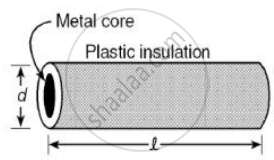Advertisements
Advertisements
Question
Which has less electrical resistance : a thin wire or a thick wire (of the same length and same material)?
Solution
A thick wire has a greater area of cross-section, whereas a thin wire has a smaller area of cross-section. Also, the resistance of a conductor is inversely proportional to its area of cross-section. This means that a thick wire has lesser resistance than a thin wire.
APPEARS IN
RELATED QUESTIONS
List the factors on which the resistance of a conductor in the shape of a wire depends.
What is meant by conductors and insulators? Give two examples of conductors and two of insulators.
Which of the following are conductors and which are insulators?
Sulphur, Silver, Copper, Cotton, Aluminium, Air, Nichrome, Graphite, Paper, porcelain, Mercury, Mica, Bakelite, Polythene, Manganin.
Calculate the resistance of a copper wire 1.0 km long and 0.50 mm diameter if the resistivity of copper is 1.7 × 10−8 Ω m.
How does the resistance of a conductor depend on:
length of the conductor?
How does the resistance of a conductor depend on:
area of cross-section of the conductor?
What would be the effect on the resistance of a metal wire of:
increasing its length?
Write the relation between resistance and electrical resistivity of the material of a conductor in the shape of a cylinder of length `'l'` and area of cross-section `'A'` . Hence derive the S.I. unit of electrical resistivity.
Use the data in the Table given below to answer the following –
Which material is the best conductor?
Table give below Electrical resistivity of some substances at 20°C
| Electrical resistivity of some substances at 20°C | ||
| − | Material | Resistivity (Ω m) |
| Conductors |
Silver | 1.60 × 10−8 |
| Copper | 1.62 × 10−8 | |
| Aluminium | 2.63 × 10−8 | |
| Tungsten | 5.20 × 10−8 | |
| Nickel | 6.84 × 10−8 | |
| Iron | 10.0 × 10−8 | |
| Chromium | 12.9 × 10−8 | |
| Mercury | 94.0 × 10−8 | |
| Manganese | 1.84 × 10−6 | |
| Alloys |
Constantan (alloy of Cu and Ni) |
49 × 10−6 |
| Manganin (alloy of Cu, Mn and Ni) |
44 × 10−6 | |
| Nichrome (alloy of Ni, Cr, Mn and Fe) |
100 × 10−6 | |
| Insulators | Glass | 1010 − 1014 |
| Hard rubber | 1013 − 1016 | |
| Ebonite | 1015 − 1017 | |
| Diamond | 1012 − 1013 | |
| Paper (dry) | 1012 | |

Plastic insulation surrounds a wire having diameter d and length l as shown above. A decrease in the resistance of the wire would be produced by an increase in the ______.
